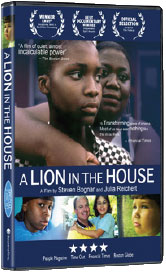 |
A Conversation with Steven Bognar and Julia Reichert
 Steven Bognar and Julia Reichert are filmmakers of the Emmy Award-winning documentary A Lion in the House, a film about the lives of five American families who each have a child battling cancer. Since its release in 2006, the film has been widely used by patient advocates and health agencies to promote greater understanding of the challenges facing pediatric patients and their families. It was recently released in a DVD edition.
Steven Bognar and Julia Reichert are filmmakers of the Emmy Award-winning documentary A Lion in the House, a film about the lives of five American families who each have a child battling cancer. Since its release in 2006, the film has been widely used by patient advocates and health agencies to promote greater understanding of the challenges facing pediatric patients and their families. It was recently released in a DVD edition.
What has been the response to the documentary, especially its use for education and advocacy?
We hoped A Lion in the House would have a cultural impact, particularly as a teaching tool. But the response has far exceeded our hopes. The movie has been used by many partner organizations to advocate for families fighting childhood cancer. It was shown in Congress to raise awareness of the need for the [Caroline Pryce Walker] Conquer Childhood Cancer Act, for example, and some of the families in the film spoke out there.
The DVD is packed with bonus features, including a short film updating viewers on all of the kids and their families. The film has been used in so many educational settings, we've lost count. At the same time, health care educators in many fields have asked for shorter clips for classroom use. So our team began - with major support from the Centers for Disease Control and Prevention, the Lance Armstrong Foundation, and SuperSibs! - tocreate from the film and its outtakes a series of targeted educational modules on selected subjects, include survivorship, health care disparities, end-of-life communication, school issues, nurse boundaries, sibling issues, and spirituality issues. Each mini-movie module comes with unique learning objectives, discussion questions, competencies, take-home points, and an in-depth resource list. The educational materials can be purchased on the Web at http://www.aquariusproductions.com.
The modules have been designed with input from a team of top experts in their respective fields, who looked at draft after draft to help us refine and improve them. They are for many audiences - medical and nursing students, residents, fellows, nurses, social workers, and others.
The module on disparities has been used to advocate for transportation support for poor families, and the school issues module has been widely used to educate school nurses and counselors on childhood cancer's impact on learning, for both children with cancer and their siblings. We are extremely gratified that many organizations in our field have embraced the film and the related modules and have found creative ways to use them.
How has your involvement in making the film affected your lives and work?
A Lion in the House changed our lives profoundly. Making the film deepened us as people and gave us a greater sense of compassion for all of our fellow human beings. We saw intimately the depth of love that exists between parent and child. The world of cancer treatment, perhaps especially childhood cancer, is populated by a particular breed of doctors, nurses, social workers, and others. We came into close contact with professional caregivers, whose dedication and sensitivity leave a lasting impression. It was the hardest film we ever made and the most gratifying.
What can potential filmmakers or advocates do if they are considering approaching a subject like this?
Be ready for the long haul. Be open to deep emotion and to the stories of others. Get to know the organizations that have been fighting for awareness of the needs of children and families facing cancer and other life threatening illnesses. Meet them face-to-face. Learn their goals and actions. It's actually a small community, full of really great people. But you'll have to be tireless and patient in finding them all and connecting.
|